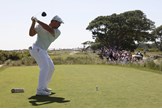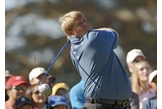Should golf tour pros really be our role models?
Published:
They are heroes to millions, but golf tour pros don’t always make the best role models…
Has Bryson DeChambeau struck the longest ever drive on the PGA Tour? Actually, he’s barely halfway. American Carl Cooper hit one 787 yards in 1992. And yes, there was a cart path involved.
Genuine feats of power are not exactly new to golf either. Some of us will recall Jack Nicklaus peeling off his sweater and driving through St Andrews’ 18th green in 1970; others might even remember John Daly reaching Baltusrol’s ‘unreachable’ uphill 630-yard 17th with a drive and 1-iron in 1993. But just a few weeks ago, DeChambeau gave us another moment. Two of them, in fact. And for some reason, these felt different.
RELATED Lower Your Golf Scores

For the half-dozen of you that still haven’t seen them, a quick recap. This was the sixth hole at Arnold Palmer’s Bay Hill layout, a horseshoe par 5 of 555 yards… if you play it round the massive lake like you’re supposed to. But on both Saturday and Sunday Bryson took the direct route, as Daly himself had done in 1998. But while Daly made an 18 that day after putting seven balls in the water, Bryson sensationally cleared the lake both times. His drives of 370 yards or thereabouts left him short pitches for albatross.
Was it the sheer absurdity of witnessing a golfer setting up on a line of seemingly endless blue ripples, as if hitting out to sea? Or the astonishment of watching Bryson’s bulky frame move with so much speed, coordination and balance? Whatever it was, these shots left me with one inescapable sensation: that tour golf, at an elite level, has never felt so different to the game you and I play.
RELATED How To Score Better On Par 5s
Okay, Bryson is a unique case. And yet there is no doubting the sheer athleticism of the world’s best golfers. We can marvel at it; we can enjoy it. But when it comes to the traditional view of our heroes as role models, things become a little more complicated.
From as early as 1930, when the PGA of America commissioned cine film instructionals of Bobby Jones, the touring professional has been our guiding light in terms of skill, technique and power. The traditional logic has been that because they perform so well, their methods are by definition worth replicating.
But the logic is flawed. Hogan’s anti-hook tips bemused a legion of slicers; Jack’s square-to-square swing damaged backs and scorecards in equal measure; Faldo’s technical rebuild killed a generation of golfers without the time, mindset, talent or incentive to follow it through. Great golfers, and heroes all; just not especially effective role models.
RELATED Phil Kenyon Saves You Six Shots

Which brings us back to Bryson. At 27 years of age, the American’s intense and creative approach to playing better golf has already made him a hero to many. Yet the way he chooses to play golf is predicated on a carefully choreographed and completely individual program of diet, exercise, technical training, equipment and practice. A hero? Sure. A role model? Surely not. You can prove it to yourself very quickly by going out tomorrow and trying to play like him. I’d advise you to have a few extra balls handy. And a couple of paracetamol.
RELATED The Mind Game Myths Damaging Your Game
Yes, there are times when using tour pros as role models makes sense. A nervy putter, for example, would do well to study the effortless swish of Rickie Fowler; the short-game rhythm and creativity of my own hero, Seve, will help golfers for evermore. But when it comes to the long game, you need to tread carefully. How much time have you got to give to the game? What are your physical limitations, and how much are you prepared to work on them? What specific issues does a player have, and how does it relate to your own? Only once you have answered questions like these can you determine which players make useful role models, and which do not.
Let’s think of this another way: there are heroes who inspire awe and admiration, and there are heroes we can learn from. Bryson is the former, but not necessarily the latter.
RELATED Best Home Golf Practice Tips
Let me give you an example of another, very different type of hero; a golfer I know who recently broke his age. This guy is 68, and just shot a 67 on a par-71 course. He can barely carry the ball 200 yards, and yet, at 68, still plays off plus-2. His ability to manage his game is extraordinary. Not glamorous, or sexy, unquestionably heroic. Here is someone any club golfer can definitely learn from.
Why not seek out similar heroes at your club? The septuagenarian who still plays off single figures? The course record holder? The guy who keeps appearing on the honours boards? Play a few holes with them. Find out what makes them tick, how they do it. Note it well: not all role models are found on tour.
READ NEXT Lee Westwood: My Life On Tour


